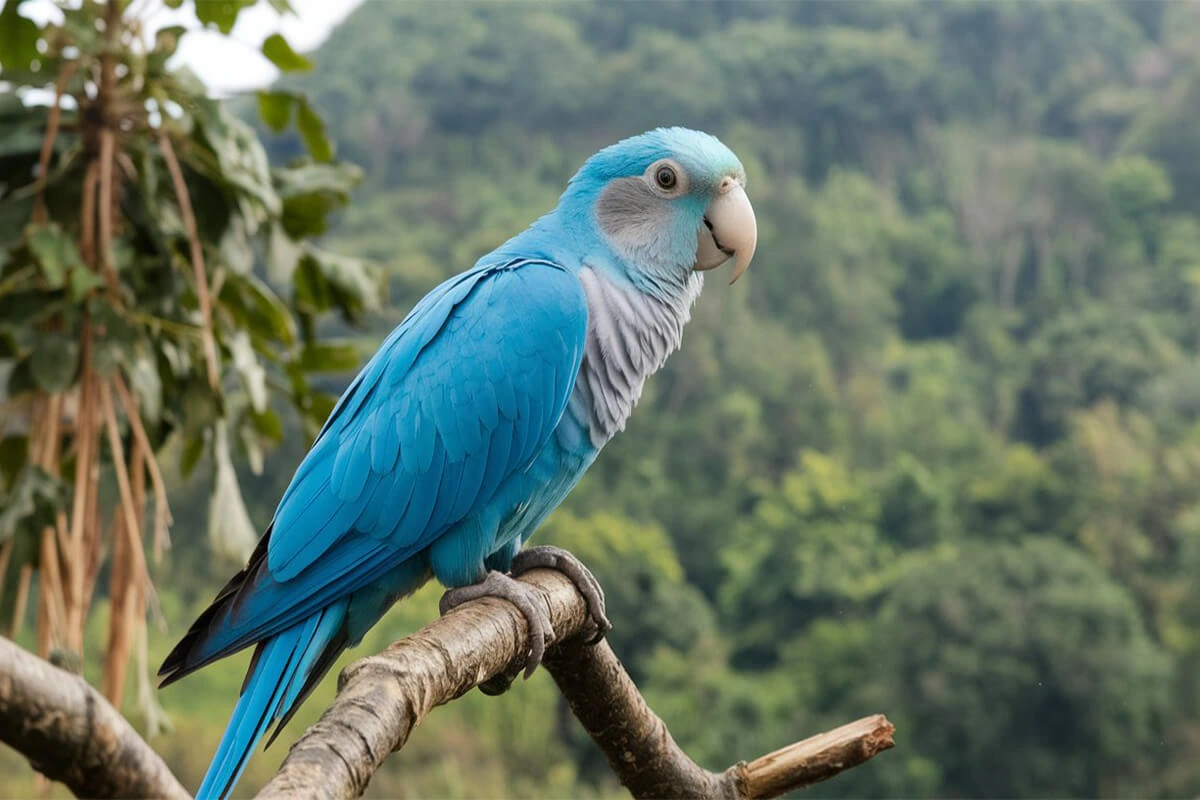The Quaker Parrot Blue mutation stands out as one of the most striking variations of the Monk Parakeet. Bird enthusiasts admire this parrot for its vibrant blue feathers, intelligence, and lively personality. Unlike the common green Quaker Parrot, the blue variation results from a genetic mutation that alters its coloration without affecting its charming traits.
People who own Blue Quaker Parrots often rave about their talkative nature, playful energy, and deep bond with their human companions. These parrots quickly learn words and phrases, making them one of the best talking birds among small parrots. However, caring for them requires dedication, as they need proper nutrition, mental stimulation, and social interaction to thrive.
In this post, you’ll discover ten surprising facts about the Blue Quaker Parrot, from its unique genetics and behavior to its lifespan, cost, and legal status. Whether you’re considering bringing one home or just curious about this beautiful bird, these facts will give you a deeper appreciation for this fascinating parrot.
What Is the Quaker Parrot Blue Mutation?
Origin of the Blue Mutation
The Blue Quaker Parrot, a color mutation of the Monk Parakeet (Myiopsitta monachus), traces its roots back to selective breeding. Wild Quaker Parrots naturally display green plumage, which helps them blend into their native environments in South America, including Argentina, Brazil, and Bolivia. Breeders first noticed the blue variation in captive birds when genetic mutations altered the pigmentation of their feathers. Over time, breeders selectively paired blue-mutation birds to produce consistent blue offspring, making them widely available in the pet trade.
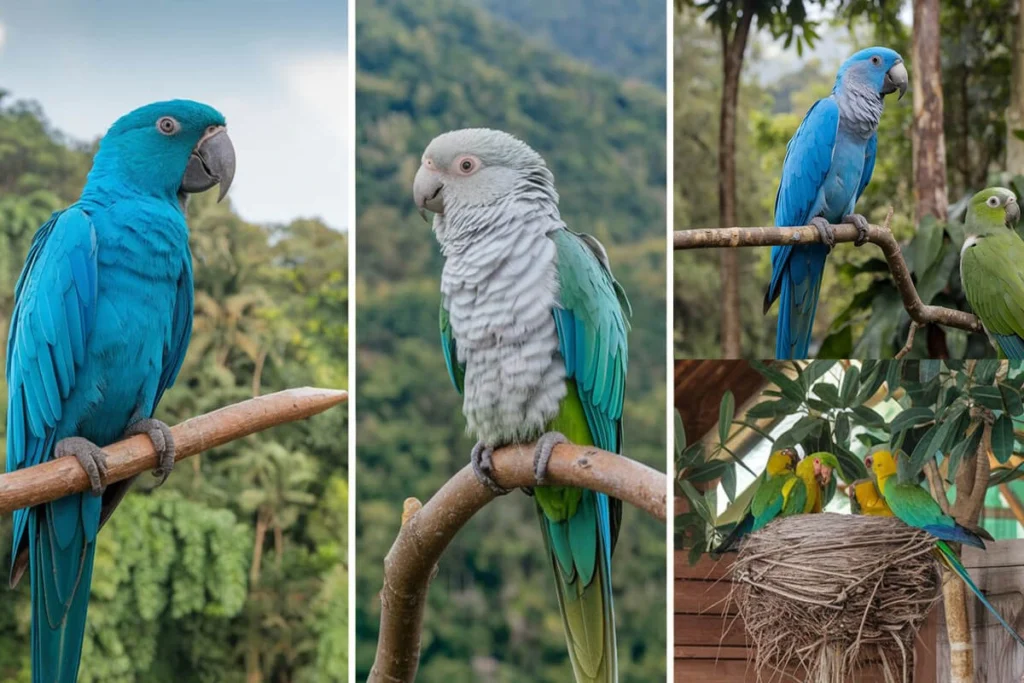
Despite their color difference, Blue Quaker Parrots share the same energetic, social, and intelligent traits as their green counterparts. They thrive in captivity and have become a favorite among bird lovers due to their striking appearance and playful personalities.
Genetics Behind the Mutation
The blue coloration in Quaker Parrots results from a recessive genetic mutation that affects feather pigmentation. Green Quaker Parrots get their color from a combination of yellow and blue pigments. The blue mutation removes the yellow pigmentation, leaving behind only the blue tones. For a Quaker Parrot to express this blue color, it must inherit the mutation from both parents.
Breeders carefully select birds that carry this recessive gene to produce more Blue Quaker Parrots. If only one parent carries the mutation, the offspring will appear green but may carry the gene for blue coloration. When two carriers breed, about 25% of the chicks will display the blue mutation. Since this mutation only affects feather color, Blue Quaker Parrots behave exactly like their green relatives, maintaining the same intelligence, social nature, and vocal abilities.
Quaker Parrot Blue Appearance
The Blue Quaker Parrot captivates bird enthusiasts with its bright blue plumage. Unlike the standard green Quaker Parrot, which has a mix of green and gray feathers, the blue variation features a sky-blue body with a light gray chest and face. Its beak remains the same pale orange color as the green variety, and its dark eyes give it an expressive and inquisitive look.
Young Blue Quaker Parrots often have a slightly duller shade of blue, which brightens as they mature. Their wings showcase deeper blue tones, creating a beautiful contrast against their softer gray face and chest. Despite the color difference, their feather structure, size, and body shape remain identical to those of green Quakers. Their stunning color makes them a popular choice for bird lovers looking for a unique yet affectionate parrot.
Personality and Behavior of The Quaker Parrot Blue
Highly Social and Intelligent
Blue Quaker Parrots thrive on social interaction and mental stimulation. In the wild, Quakers live in large flocks, building elaborate communal nests that support their highly social lifestyle. In captivity, they form deep bonds with their owners and crave companionship. If left alone for long periods, they may develop behavioral issues such as excessive screaming or feather plucking due to loneliness or boredom.
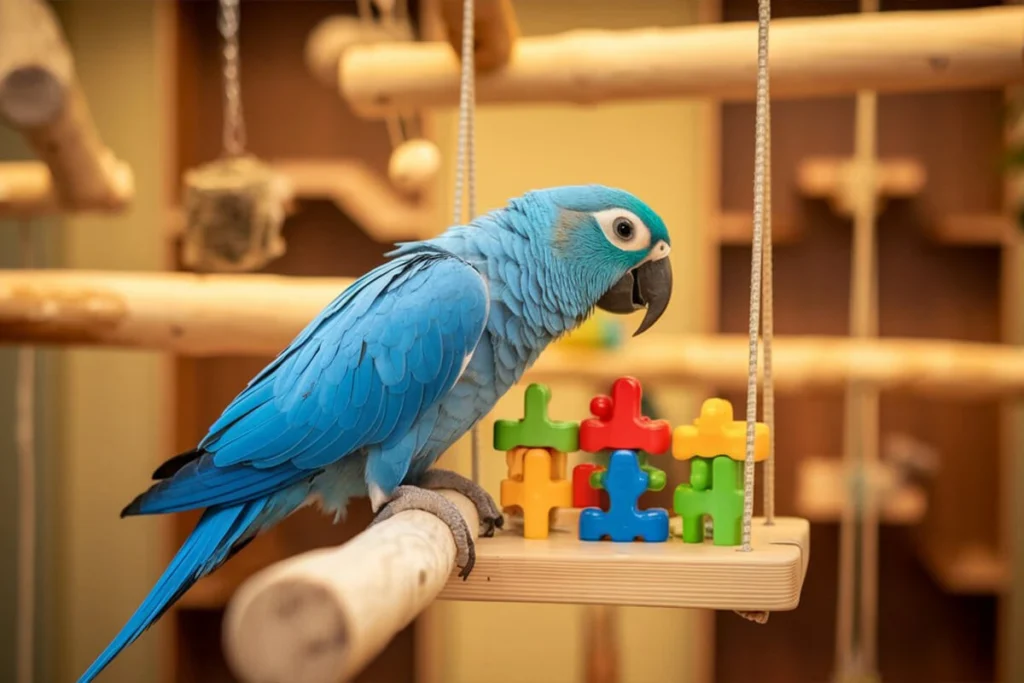
Their intelligence sets them apart from many other parrot species. They quickly recognize patterns, solve simple puzzles, and learn new tricks with ease. Owners often find that their Blue Quaker Parrot enjoys problem-solving activities, such as opening cage latches or figuring out how to retrieve treats from foraging toys. Their sharp minds require constant engagement, so owners should provide a variety of interactive toys and spend quality time with them daily. Without proper mental stimulation, they may resort to destructive behaviors to entertain themselves.
Talking Ability
Blue Quaker Parrots rank among the best talkers in the parrot world. They develop an impressive vocabulary and mimic human speech with surprising clarity. Some birds learn to string together entire sentences, while others develop unique phrases based on what they frequently hear. Unlike some parrots that merely mimic sounds, Quakers often use words in context, making interactions with them even more fascinating.
Training a Quaker Parrot to talk requires consistency and patience. Owners who repeat words and phrases enthusiastically will see quicker results. These birds respond well to positive reinforcement, so rewarding them with treats or affection encourages them to practice their speech. Many Blue Quaker Parrots start talking as early as six months old, but some take a little longer to develop their vocal skills.
Besides mimicking words, Quakers love to imitate household noises, such as doorbells, phone ringtones, or even laughter. Their ability to pick up and reproduce sounds makes them endlessly entertaining companions.
Playfulness and Energy
Blue Quaker Parrots bring nonstop energy into their environment. They love to climb, explore, and interact with anything that catches their interest. Since they naturally enjoy building and arranging objects, they often create their own play structures using toys, sticks, or shredded paper. This instinct comes from their wild nesting habits, where they construct large, elaborate nests in colonies.
Owners should provide a mix of chew toys, climbing structures, and puzzle feeders to keep their Quaker entertained. Without enough activities, they may channel their energy into chewing on furniture or other household items. Their playful nature also extends to social interactions—many enjoy games like peek-a-boo, fetch, or even dancing to music.
Since they have boundless energy, they need plenty of out-of-cage time to stretch their wings and explore their surroundings. Regular interaction strengthens their bond with their owner and prevents boredom-related issues. Their playful, affectionate, and curious personality makes them one of the most engaging parrots to keep as a pet.
Essential Care Tips for a Happy Quaker Parrot Blue
Diet and Nutrition
Feeding a Blue Quaker Parrot a balanced diet ensures a long, healthy life. These parrots thrive on a mix of high-quality pellets, fresh fruits, vegetables, and a moderate amount of seeds. Many owners mistakenly rely too heavily on seeds, but seeds alone lack essential nutrients and can lead to obesity and vitamin deficiencies. A pellet-based diet provides the necessary vitamins and minerals while reducing the risk of health issues.
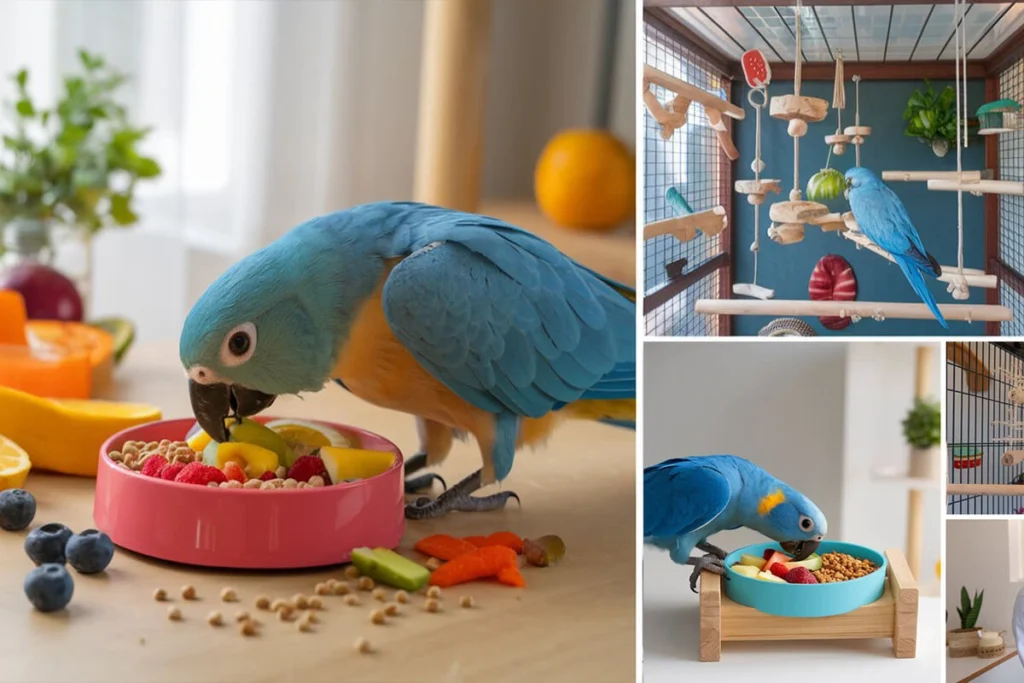
Fresh fruits and vegetables add variety and important nutrients to their diet. Quakers enjoy foods like apples, bananas, carrots, bell peppers, broccoli, and leafy greens. Owners should avoid avocados, chocolate, caffeine, and onions, as these can be toxic to parrots. Offering a mix of foods keeps meals interesting and prevents picky eating habits.
Since Quaker Parrots love to chew and explore, providing food in creative ways—such as stuffing treats into foraging toys—keeps them mentally stimulated. Fresh water should always be available, and owners should clean food and water bowls daily to prevent bacterial growth.
Cage Requirements
Blue Quaker Parrots need a spacious, well-equipped cage to stay happy and healthy. Since they are active birds, their cage should be large enough to allow plenty of movement. A minimum size of 24” x 24” x 24” works for a single Quaker, but bigger is always better. Bar spacing should be ½ to ⅝ inches to prevent injuries.
Perches of varying sizes and materials help keep their feet strong and prevent pressure sores. Natural wood perches, rope perches, and even platform perches provide variety. These parrots love to climb, so adding ladders, ropes, and swings enhances their environment.
Toys play a crucial role in their mental stimulation. Quakers need chew toys, puzzle toys, and shreddable materials to satisfy their natural instincts. Owners should rotate toys regularly to keep their bird engaged and prevent boredom. Additionally, Quakers can be territorial about their cage, so early socialization and training help minimize aggressive behavior.
Since Quakers love to build nests, many enjoy having a designated nesting area in their cage. However, if this encourages territorial aggression, owners should monitor their bird’s behavior and adjust the setup as needed.
Common Health Concerns
A well-cared-for Blue Quaker Parrot can live 20 to 30 years, but like all parrots, they are prone to certain health issues. Recognizing early signs of illness helps owners provide timely care.
One of the most common health problems is feather plucking, often caused by boredom, stress, or nutritional deficiencies. Ensuring a stimulating environment and a balanced diet reduces the risk of this behavior.
Respiratory infections can also affect Quakers, especially if they live in drafty or smoky environments. Symptoms include wheezing, nasal discharge, or labored breathing. Keeping their living space clean and free from airborne toxins helps prevent respiratory problems.
Another concern is fatty liver disease, which develops from a poor diet high in fatty seeds. Symptoms include lethargy, a swollen abdomen, and a dull feather appearance. Feeding a pellet-based diet with fresh produce helps prevent this condition.
Regular vet checkups, a clean environment, and a nutritious diet go a long way in keeping a Blue Quaker Parrot healthy and thriving. Owners who stay attentive to their bird’s behavior and physical condition can quickly address any health concerns before they become serious.
Lifespan and Cost of Owning a Quaker Parrot Blue
How Long Do They Live?
Blue Quaker Parrots live 20 to 30 years when they receive proper care, making them a long-term commitment for any bird owner. Their lifespan depends on several factors, including diet, environment, mental stimulation, and regular veterinary checkups. Quakers that eat a well-balanced diet, get plenty of exercise, and receive daily social interaction tend to live longer and healthier lives.
Mental health plays a huge role in their longevity. Since these birds form strong bonds with their owners, they can suffer from stress or depression if neglected. A lonely Quaker may develop self-destructive behaviors such as feather plucking or excessive screaming. Owners who provide consistent companionship, toys, and engaging activities help their birds stay happy and reduce stress-related health issues.
Genetics also influence lifespan. Birds from responsible breeders often have fewer hereditary health issues than those from poor breeding conditions. Regular vet checkups help detect potential health problems early, allowing for preventive care. With the right environment and attention, a Blue Quaker Parrot can become a lifelong companion.
Quaker Parrot Blue Price
The price of a Blue Quaker Parrot varies based on factors like breeder reputation, location, and demand. On average, these birds cost $400 to $700, but prices can rise if the parrot comes from a specialized breeder with a strong bloodline.
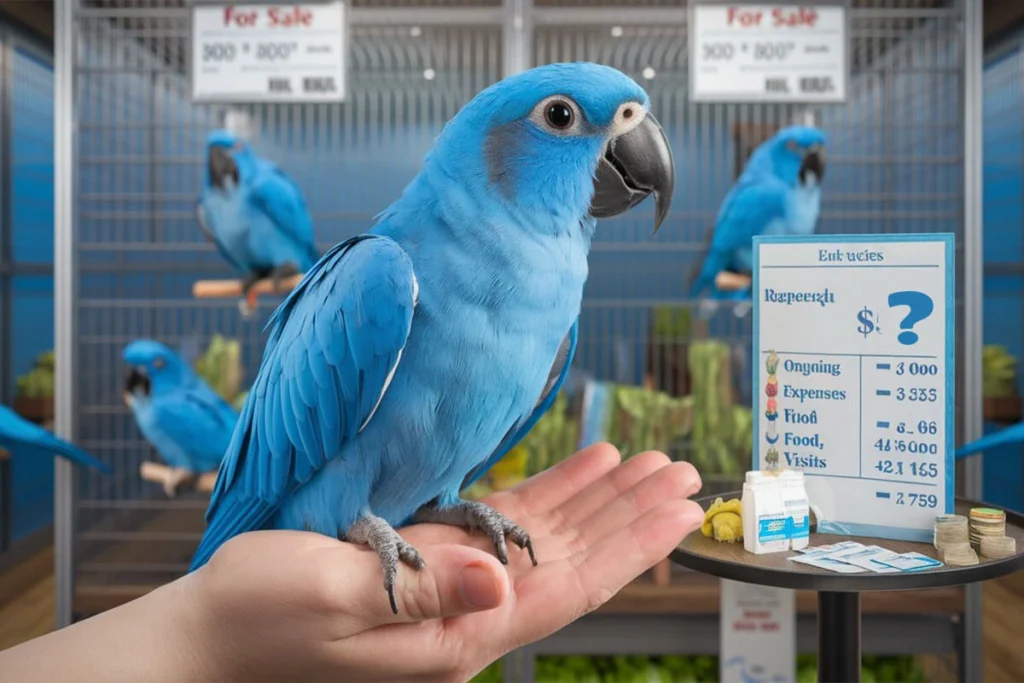
Several factors affect the price:
- Mutation Rarity: Blue Quakers are more expensive than standard green Quakers because their color mutation results from selective breeding.
- Breeder vs. Pet Store: Birds from reputable breeders often cost more because they receive better care, socialization, and health screenings before being sold.
- Hand-Fed vs. Parent-Raised: Hand-fed babies cost more because they are well-socialized, making them easier to train and bond with.
- Location: Availability varies by region. In areas where Blue Quakers are less common, prices may be higher due to demand.
Prospective owners should research breeders carefully to avoid purchasing from unethical sources or bird mills. Choosing a healthy, well-socialized Quaker ensures a smoother transition into pet life.
Ongoing Expenses
Owning a Blue Quaker Parrot requires more than just the initial purchase price. These birds need continuous care, which comes with monthly and annual costs.
Food and Nutrition
A balanced diet includes high-quality pellets, fresh fruits, vegetables, and occasional treats. Owners typically spend $20 to $50 per month on food, depending on the variety and quality of ingredients.
Cage and Accessories
A proper cage costs $100 to $300, but this is a one-time purchase. However, perches, ladders, swings, and nesting materials need periodic replacement, adding $50 to $100 per year in maintenance costs.
Toys and Enrichment
Quakers need chew toys, foraging toys, and interactive playthings to stay mentally stimulated. Owners should rotate toys regularly to prevent boredom. Toy expenses range from $10 to $30 per month.
Veterinary Care
Regular vet visits help detect health problems early. A basic checkup costs $50 to $100, while emergency visits or treatments can exceed $200 to $500. Owners should budget for annual exams and unexpected medical needs.
Other Expenses
Additional costs include grooming (beak, nail, and wing trimming), cleaning supplies, and potential pet-sitting services if the owner travels. These miscellaneous expenses can add another $100 to $200 per year.
While Blue Quaker Parrots bring joy and companionship, they require a financial commitment. Responsible owners plan for both upfront and long-term costs to ensure their feathered friend receives the best possible care.
Legal Considerations and Habitat Facts About Quaker Parrot Blue
Where Are Quaker Parrots Legal?
Quaker Parrots, including the Blue Quaker mutation, face legal restrictions in several regions. Some U.S. states ban or regulate ownership because these birds have the potential to establish wild colonies that disrupt local ecosystems and agriculture. States such as California, Georgia, Hawaii, Kentucky, Pennsylvania, Rhode Island, Tennessee, and Wyoming prohibit ownership entirely. Other states, like New Jersey and Connecticut, allow Quaker Parrots but require permits or wing clipping to prevent them from escaping and breeding in the wild.
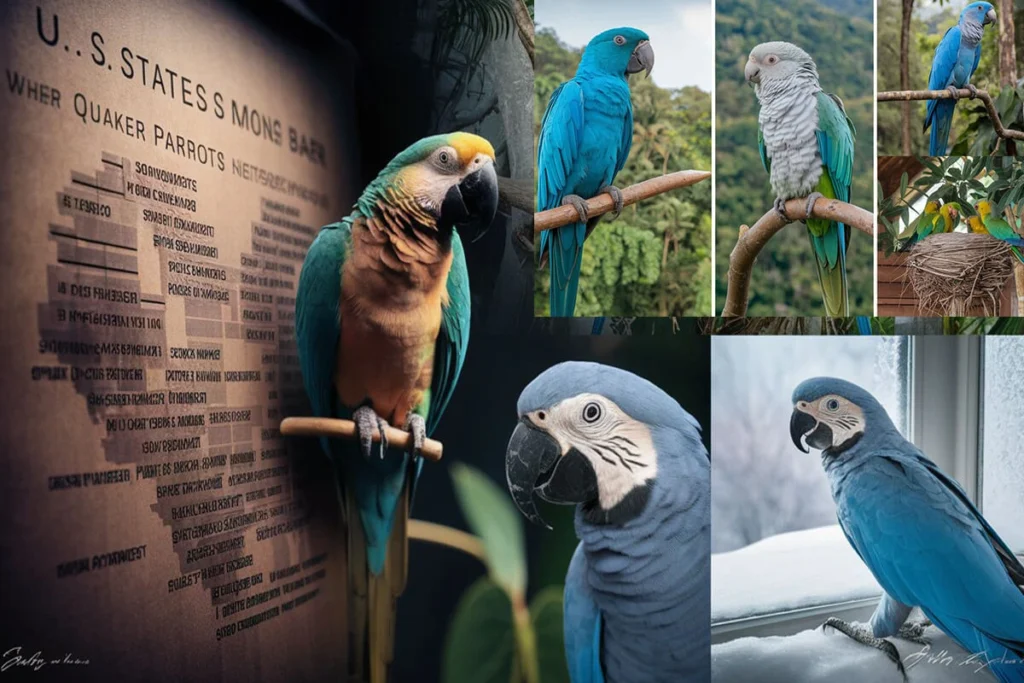
Government agencies consider Quakers an invasive species because of their ability to survive in colder climates and form large, communal nests. In areas where wild colonies exist, these nests sometimes cause problems by damaging electrical infrastructure, particularly power lines and transformers. Officials in some states have removed wild Quaker nests to prevent potential hazards.
Before purchasing a Blue Quaker Parrot, prospective owners should research local laws and regulations. Violating these laws can result in fines or the forced surrender of the bird. Checking with state wildlife agencies or local exotic pet regulations ensures a legal and responsible ownership experience.
Native Habitat
The Quaker Parrot originates from South America, thriving in countries like Argentina, Brazil, Bolivia, Paraguay, and Uruguay. Unlike many other parrots that prefer dense rainforests, Quakers live in woodlands, savannas, and urban areas, showing remarkable adaptability to different environments.
In their natural habitat, Quakers form large social flocks and build intricate communal nests in trees or on man-made structures. These nests, made from twigs and branches, feature multiple chambers, allowing several birds to live together. This unique nesting behavior sets them apart from most parrot species, which typically nest in tree hollows.
Quakers prefer areas with abundant food sources, including fruit-bearing trees, grassy fields, and agricultural lands. Farmers in South America sometimes view them as pests because they feed on crops like corn, wheat, and fruit orchards. Despite this, their high intelligence and adaptability allow them to coexist with humans in rural and urban settings.
Adaptability
Quaker Parrots have demonstrated an incredible ability to adapt to various climates and environments. Unlike many tropical parrots that struggle in cold weather, Quakers tolerate lower temperatures better due to their nesting habits. Their large, insulated nests help regulate warmth, allowing them to survive in places with seasonal temperature changes. This adaptability explains why feral Quaker populations have successfully established themselves in the United States, Spain, Italy, and even parts of the United Kingdom.
In captivity, Blue Quaker Parrots adjust well to home environments when they receive proper care. They thrive in spacious cages with plenty of toys, perches, and social interaction. Their diet flexibility also contributes to their adaptability, as they can eat a wide range of fruits, vegetables, and pellets.
Quakers also display emotional adaptability by forming strong bonds with their owners. They recognize routines, learn commands quickly, and adjust to changes in their environment when introduced gradually. However, they require consistency and mental stimulation to prevent stress-related behaviors, such as excessive screaming or feather plucking.
Their ability to survive in diverse environments, from South American woodlands to urban apartment settings, makes them one of the most resilient and versatile parrots in the world.
Conclusion
The Blue Quaker Parrot stands out as a remarkable pet, offering a unique combination of intelligence, social charm, and playful energy. Its striking blue coloration, a result of a fascinating genetic mutation, makes it a sought-after variation of the traditional green Quaker Parrot. With proper care, these birds can live 20 to 30 years, forming deep, lifelong bonds with their owners. However, potential owners must understand that Quakers require consistent interaction, mental stimulation, and a well-balanced diet to thrive.
Beyond their captivating appearance, Blue Quakers are known for their exceptional talking ability, problem-solving skills, and playful personality. They love to mimic human speech, engage in interactive play, and explore their surroundings. Their highly social nature means they crave attention, and neglect can lead to behavioral issues such as excessive screaming or feather plucking. Providing a spacious cage, varied toys, and a stimulating environment ensures a happy and well-adjusted parrot.
Owning a Blue Quaker Parrot comes with responsibilities, including financial commitments for food, toys, vet care, and cage maintenance. Additionally, prospective owners must check local laws since Quakers are banned in some U.S. states due to their potential to form feral colonies.
For those willing to invest time and effort, the Blue Quaker Parrot offers endless companionship, entertainment, and joy. Their affectionate nature and engaging personality make them one of the most rewarding pet birds to own. By understanding their needs and providing proper care, owners can enjoy a fulfilling relationship with these intelligent and charismatic parrots for decades.
Find Out More about Other Pets and breeds From HERE!
Find Out the Best stuff for your Pet On Pet MD Official
